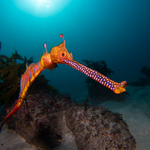This blog will examine the two types of surface marker buoy and the differences between them.
There are two types of marker buoys are commonly used by divers:
Surface marker buoy (SMB)
Delayed surface marker buoy (DSMB)
The generic term “surface marker buoy” is often applied to both types of buoy, despite the fact that they have very different designs and applications.
Design and Application
Surface marker buoy (SMB)
An SMB is typically a round, highly visible buoy that is inflated and left at the surface prior to the dive. The buoys are sealed to prevent them from deflating during the dive. They are made from a durable, buoyant material, and are typically colored red, yellow, or orange.
Some buoys have writing on them or an attached flag to increase their visibility. Divers use an SMB to communicate their position to topside personnel in open water, where a decompression or anchor line is not available or where current conditions make a drifting ascent preferable.
Delayed surface marker buoy (DSMB)
A DSMB is a long, cylindrically shaped tube that is typically carried while rolled up in a compact package by the diver during the dive. They are attached to a line then inflated, and are used by divers to signal their position or to communicate with surface personnel near the end of the dive.
DSMBs are made from similar materials as SMBs and are brightly colored to increase visibility. The DSMB can be deployed while submerged, so the most important rule when choosing a DSMB is to verify that there is enough line on the reel or spool to enable the buoy to reach the surface.
Once deployed, the reel or spool can serve as a depth reference point for team members as they make safety or decompression stops. DSMBs typically come in three designs:
Open-ended
These DSMBs are inflated by adding gas from an alternate gas source. The bottom is open, which allows the diver to fill the DSMB, but they must keep some tension on the line to prevent gas from escaping at the surface.
Self-sealing
These DSMBs can also be inflated by filling them with gas through an opening at the bottom of the DSMB. As the DSMB ascends, the bottom end seals, preventing gas from escaping.
Sealed
A sealed DSMB has an inflation valve that can either be orally inflated or fitted to a low-pressure gas supply that is similar to the low-pressure inflator used on buoyancy compensators or dry suits. The diver fills the buoy from a low-pressure inflator; usually from their buoyancy compensator, their wing, their dry suit, or an off-board gas supply. An overpressure valve prevents the expanding gas from tearing the buoy as it ascends to the surface.
Head to https://www.youtube.com/watch?v=Slu6k_USbO0 to see how to orally inflate a sealed DSMB.
Diver Identification
Labeling the DSMB helps identify the decompressing diver(s). A team generally only deploys one DSMB, but additional DSMBs can carry slates to the surface, communicate the need for help, or signal a change in diver status.
Some divers use a specific color for the DSMBs that indicate “all is well” or “problem below”, but there is not a global consensus on which colors indicate which signal.
If you would like to learn more about how to use the different types of surface markers buoys effectively then join the SSI Extended Range program or head to https://www.divessi.com/en/advanced-training/extended-range for more information.
The post SMB or DSMB – What is the difference? appeared first on Dive SSI.
Read MoreExtended Range, buoy, DSMB, SMB, surface marker, surface marker buoyDive SSI

